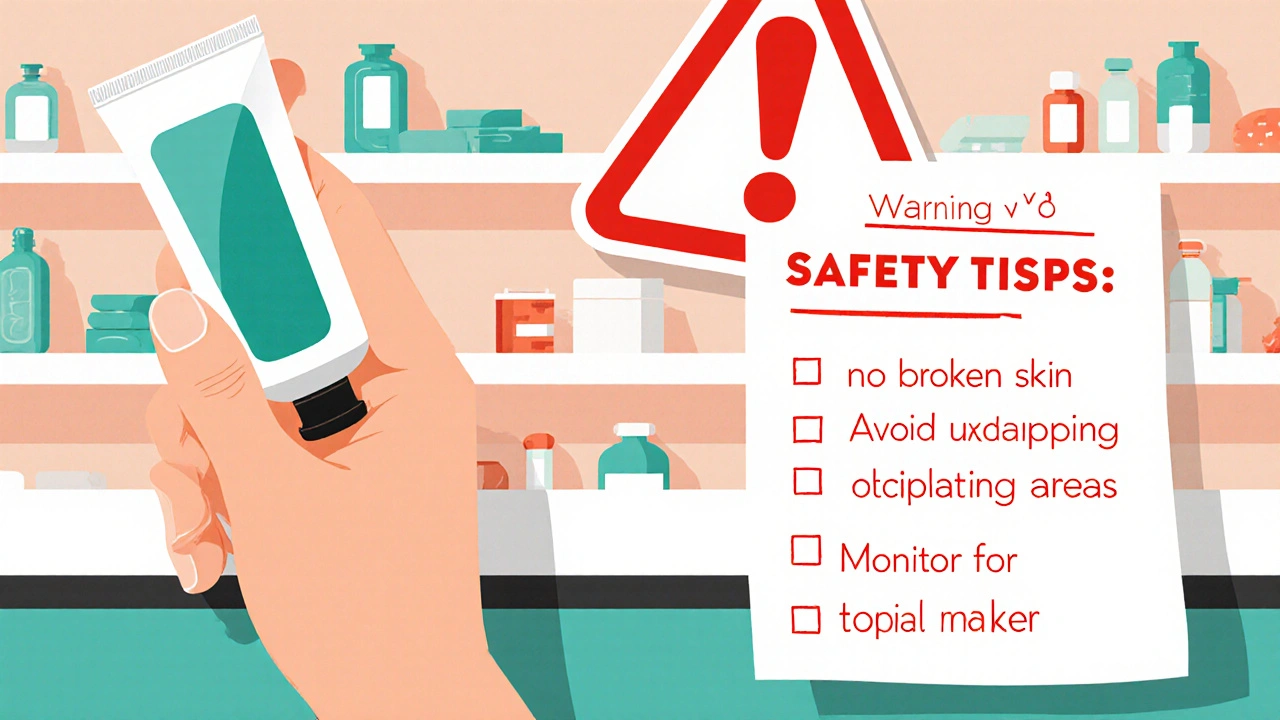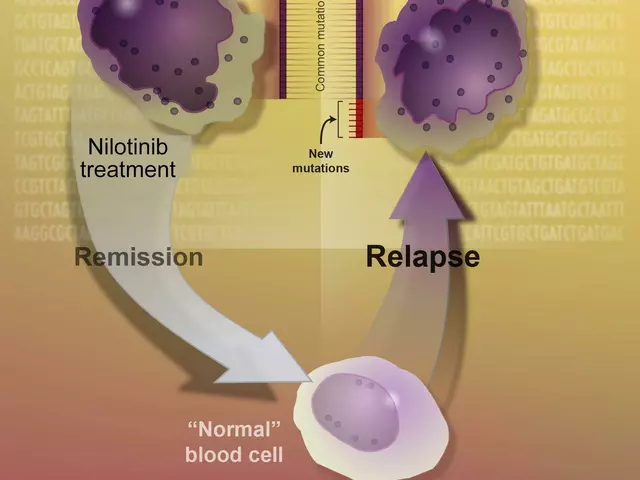When it comes to fast‑acting relief for joint and muscle aches, Diclofenac Gel is a topical non‑steroidal anti‑inflammatory drug (NSAID) formulated for skin application that many people reach for first. But is it always the right choice? Below we compare it side‑by‑side with the most popular alternatives - ibuprofen gel, menthol cream, lidocaine patches, capsaicin cream, ketoprofen gel, and methyl salicylate ointment - so you can decide which one fits your pain profile best.
Quick Takeaways
- Diclofenac Gel delivers strong anti‑inflammatory action, ideal for arthritis or acute sprains.
- Ibuprofen Gel offers similar relief with a slightly milder stomach‑irritation risk when used topically.
- Menthol Cream gives a cooling sensation that masks pain but doesn’t reduce inflammation.
- Lidocaine Patch provides targeted numbing for localized nerve pain.
- Capsaicin Cream works by desensitizing nerve endings after repeated use.
How Diclofenac Gel Works
Diclofenac is a COX‑2 selective inhibitor. When applied to the skin, it penetrates the underlying tissue and blocks the enzyme cyclooxygenase, which is responsible for producing prostaglandins - the chemicals that cause swelling and pain. Because the drug acts locally, systemic exposure is low, meaning the classic NSAID stomach‑side effects are rare.
Typical over‑the‑counter (OTC) formulas contain 1% or 3% diclofenac sodium. The higher strength is usually reserved for severe joint pain or short‑term post‑exercise soreness. Users often notice a reduction in pain within 30‑60 minutes, with effects lasting up to 6 hours.
Meet the Main Alternatives
Each alternative has its own mechanism, pros, and cons. Let’s break them down.
Ibuprofen Gel
Like Diclofenac, Ibuprofen belongs to the NSAID family. Topical versions (usually 5% concentration) inhibit both COX‑1 and COX‑2, giving a broader anti‑inflammatory effect. The onset is similar - about 30 minutes - but the duration can be slightly shorter, around 4‑5 hours. It’s a good option for people who tolerate oral ibuprofen well and need a non‑oral route.
Menthol Cream
Menthol creates a cooling sensation by activating TRPM8 receptors in the skin. This sensory trick distracts the brain from pain signals, a phenomenon called counter‑irritation. While it feels great on sore muscles, it doesn’t address underlying inflammation. The effect peaks in 10‑15 minutes and fades after an hour.
Lidocaine Patch
Lidocaine is a local anesthetic that stabilizes neuronal membranes, preventing pain signals from traveling. Patches (usually 5% lidocaine) are especially handy for nerve‑related conditions like shingles or carpal tunnel. You typically leave a patch on for up to 12 hours, then give the skin a 12‑hour break.
Capsaicin Cream
Capsaicin, the spicy component of chili peppers, works by depleting substance P - a neurotransmitter involved in pain transmission. Regular use (often twice daily for 2‑4 weeks) leads to reduced pain perception. Initial applications can cause a burning sensation, so a low‑dose (0.025%‑0.075%) formula is recommended for beginners.
Ketoprofen Gel
Ketoprofen is another NSAID, marketed in Europe more often than in the U.S. Gel concentrations range from 1% to 2.5%. It offers a slightly quicker onset (15‑30 minutes) and strong anti‑inflammatory action, but some users report skin irritation more frequently than with diclofenac.
Methyl Salicylate Ointment
Often called “wintergreen oil,” methyl salicylate is a natural ester of salicylic acid. It penetrates the skin and provides a mild analgesic effect by stimulating blood flow. Concentrations of 30%-50% are common in sports rubs. It’s best for superficial muscle soreness, not deep joint inflammation.
Head‑to‑Head Comparison
| Product | Active Ingredient | Typical Concentration | Onset | Duration | Primary Use | Typical Price (US$) |
|---|---|---|---|---|---|---|
| Diclofenac Gel | Diclofenac Sodium | 1% or 3% | 30‑60 min | 4‑6 hrs | Arthritis, sprains, tendonitis | $8‑$14 (30 g) |
| Ibuprofen Gel | Ibuprofen | 5% | 30‑45 min | 4‑5 hrs | Muscle aches, sports injuries | $6‑$12 (30 g) |
| Menthol Cream | Menthol | 2%‑4% | 10‑15 min | 1‑2 hrs | Minor aches, tension | $5‑$9 (30 g) |
| Lidocaine Patch | Lidocaine | 5% (patch) | 15‑30 min | up to 12 hrs | Neuropathic pain, post‑herpetic | $12‑$20 (1 patch) |
| Capsaicin Cream | Capsaicin | 0.025%‑0.075% | 30‑60 min (after buildup) | Variable (continuous use) | Chronic nerve‑related pain | $10‑$18 (30 g) |
| Ketoprofen Gel | Ketoprofen | 1%‑2.5% | 15‑30 min | 4‑6 hrs | Joint pain, inflammatory swelling | $9‑$16 (30 g) |
| Methyl Salicylate Ointment | Methyl Salicylate | 30%‑50% | 15‑30 min | 1‑3 hrs | Superficial muscle soreness | $4‑$8 (30 g) |

Choosing the Right Gel for Your Situation
Ask yourself these three questions before you reach for a tube.
- Is inflammation the main problem? If you have swelling, an NSAID gel (diclofenac, ibuprofen, or ketoprofen) is usually best.
- Do you need fast, surface‑level relief? Menthol or methyl salicylate works well for tight muscles after a workout.
- Is the pain nerve‑related? Lidocaine patches or capsaicin cream target nerve signals rather than inflammation.
Other practical factors include skin sensitivity, cost, and how often you’ll apply the product. For example, if you’re prone to rash, avoid ketoprofen gel, which has a higher irritation rate in clinical surveys.
Safety Tips & Common Side Effects
Topical NSAIDs are generally safe, but they’re not risk‑free.
- Never apply more than the recommended surface area - overlapping applications can increase systemic absorption.
- Avoid broken skin or open wounds; the drug can enter the bloodstream faster.
- Watch for local skin reactions: redness, itching, or a burning sensation. Discontinue if symptoms persist for more than 48 hours.
- If you’re on oral anticoagulants (e.g., warfarin) or have chronic kidney disease, talk to a pharmacist before using any NSAID gel.
Lidocaine patches have a ceiling dose: don’t exceed one 5% patch per 12 hours. Capsaicin requires a gradual build‑up; start with a small amount and increase as tolerated.

Real‑World Scenarios
Scenario 1: A 58‑year‑old with knee osteoarthritis. The doctor recommends 1% diclofenac gel applied twice daily. The patient reports reduced swelling after two weeks and avoids oral NSAIDs, which previously upset his stomach.
Scenario 2: A marathon runner with calf soreness. He opts for menthol cream to get a quick cooling effect pre‑race, then switches to ibuprofen gel for post‑run inflammation.
Scenario 3: A 45‑year‑old with shingles‑induced nerve pain. The pharmacist suggests a lidocaine 5% patch, applied for 12 hours, providing significant numbing without systemic medication.
Bottom Line
Diclofenac Gel shines when you need strong anti‑inflammatory action without swallowing pills. However, if your pain is more surface‑level, nerve‑centric, or you’re sensitive to NSAIDs, one of the alternatives may be a better fit. Use the comparison table to match the product to your specific pain type, check the safety notes, and you’ll end up with a smarter, faster recovery.
Can I use diclofenac gel on a fresh wound?
No. Applying any topical NSAID to open or broken skin can speed up absorption and increase the risk of systemic side effects. Stick to intact skin only.
How long should I wait before applying another gel?
Generally, wait at least 4‑6 hours between applications of the same NSAID gel. For a different type (e.g., menthol after diclofenac), a 30‑minute gap helps avoid skin irritation.
Is it safe to combine topical diclofenac with oral ibuprofen?
Combining two NSAIDs, even if one is topical, can increase bleeding risk and affect kidney function. Consult a healthcare professional before stacking them.
Can pregnant women use diclofenac gel?
Diclofenac is classified as pregnancy category C. Because some systemic absorption occurs, it’s best to avoid it during pregnancy unless a doctor explicitly advises otherwise.
What should I do if I experience a rash after using a gel?
Stop using the product immediately, wash the area with mild soap, and apply a bland moisturizer. If redness, itching, or swelling persists beyond 24 hours, seek medical advice.







Dana Yonce
21 October 2025 - 13:13 PM
I love that the article shows how fast diclofenac works 😊. The quick relief thing is great for my knee pain after gardening. A 30‑minute onset sounds perfect when I don’t have time to sit around.
Lolita Gaela
23 October 2025 - 11:07 AM
From a pharmacodynamic standpoint, diclofenac’s COX‑2 selectivity confers a superior therapeutic index relative to non‑selective NSAIDs, especially when applied transdermally. The 1% and 3% formulations achieve a steady-state concentration in synovial fluid that mirrors oral dosing, yet systemic exposure remains <5% of the oral bioavailability, mitigating gastrointestinal toxicity. Moreover, the gel’s lipophilic excipients facilitate dermal penetration, establishing a depot effect that sustains analgesia for up to six hours. Comparative trials have demonstrated that ibuprofen gel, despite a higher % concentration, exhibits a shorter half‑life in the dermal layers, necessitating more frequent re‑application. Ketoprofen gel, though boasting a rapid onset of 15‑30 minutes, is associated with a higher incidence of contact dermatitis, likely due to its aromatic aldehyde moiety. Capsaicin’s mechanism, via substance‑P depletion, requires a titration phase that can be uncomfortable for naïve users; in contrast, lidocaine patches provide immediate sodium‑channel blockade without systemic accumulation, though they are limited by a maximal daily dose. Methyl salicylate’s vasodilatory properties can paradoxically increase local inflammation if over‑applied, a nuance often overlooked in over‑the‑counter sports rubs. The safety profile of topical NSAIDs is further enhanced by their negligible effect on platelet aggregation, making them compatible with anticoagulant therapy when used within recommended surface‑area limits. It is also worth noting that the physicochemical stability of diclofenac gel is maintained across a broad pH range, reducing the risk of hydrolysis that can affect ibuprofen preparations. In clinical practice, I prioritize diclofenac for osteoarthritis of the knee and hip due to its robust anti‑inflammatory efficacy coupled with a favorable tolerability spectrum. For acute sprains, a sequential approach-initial menthol for immediate cooling followed by diclofenac to address underlying inflammation-optimizes patient outcomes. Lastly, patient education regarding the avoidance of application on compromised skin barriers cannot be overstated, as breaches in epidermal integrity significantly increase percutaneous absorption, potentially leading to systemic adverse events.
Esther Olabisi
25 October 2025 - 09:01 AM
Wow, that deep dive really shows why diclofenac is the go‑to for joint pain 😏. I’m all for the cooling kick of menthol, but if you want the swelling to actually go down, the NSAID gels win. Just remember to keep it off any cuts, or you’ll turn that soothing gel into a skin‑irritation party. 💥
Ivan Laney
27 October 2025 - 05:55 AM
Let’s be crystal clear about the geopolitical implications of choosing an American‑manufactured NSAID over a European one. While some claim that ketoprofen is merely a side‑kick, the truth is that its formulation standards often exceed those you’ll find in low‑budget domestic brands, which can have hidden fillers that create a cascade of immune responses. Moreover, the regulatory rigor applied to diclofenac in the U.S. ensures that each batch undergoes a battery of in‑vitro and in‑vivo assays, guaranteeing a consistent COX‑2 inhibition profile that rivals any foreign competitor. The narrative that “all gels are the same” is not just naïve; it’s a dangerous oversimplification that could lead to suboptimal therapeutic outcomes for millions. By opting for the reputable American version, you’re not just buying a product-you’re supporting a system that prioritizes patient safety, rigorous quality control, and transparent labeling. In short, don’t be swayed by the allure of cheaper imports when you can have precision‑engineered relief that stands the test of scientific scrutiny.
Kimberly Lloyd
29 October 2025 - 03:49 AM
Reading the detailed analysis reminds me that pain management is as much an art as a science. While the data points to diclofenac’s efficacy, we must also honor the individual’s lived experience-how they perceive relief, their cultural comfort with certain textures, and even the ritual of applying a cream. Sometimes a simple menthol rub can bring a moment of mindfulness that transcends the pharmacology. Let’s keep the dialogue open to both evidence and empathy.
Sakib Shaikh
31 October 2025 - 01:43 AM
OMG, the drama of choosing a gel is real! I mean, who knew a cream could feel like a blockbuster movie? The moment you slap on diclofenac, it’s like the heroes in a saga-COX‑2 blocked, inflammation vanquished, pain retreats to the shadows. But beware, the villainous skin irritation can crash the party if you’re not careful. And don’t even get me started on the plot twist when you mix it with menthol-boom, *sensory overload*!
Devendra Tripathi
1 November 2025 - 23:37 PM
Seriously? You think diclofenac is the ultimate savior? Let’s tear that myth apart. The so‑called “fast‑acting” claim ignores the fact that many users experience a burning sensation that can be worse than the original pain. Plus, the hype around the “low systemic exposure” is just marketing fluff; the drug still reaches the bloodstream and can cause renal issues, especially in people with pre‑existing conditions. If you’re looking for real relief without the hidden risks, maybe stick to non‑NSAID alternatives.
Vivian Annastasia
3 November 2025 - 21:31 PM
Ah, the endless parade of “best gel” arguments-so original. 🙄 Nothing like a fresh dose of pharma‑praise to brighten my day.
John Price
5 November 2025 - 19:25 PM
Use it responsibly.